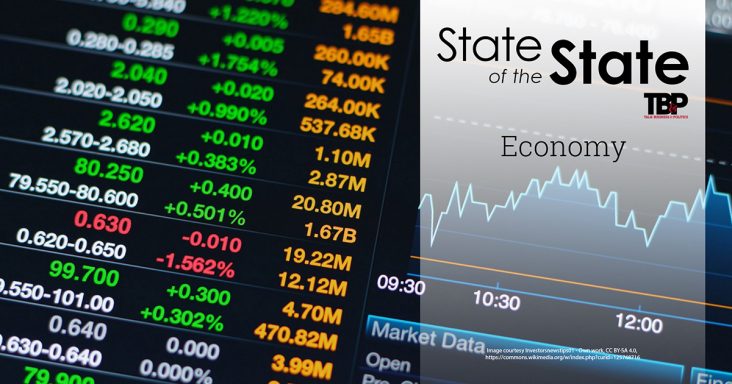State of the State 2023: Slower economic growth likely, with rebound in 2024
by January 31, 2023 11:07 am 997 views

The U.S. and Arkansas economies may have 99 problems, or more considering inflation, but a recession in 2023 ain’t one of them. Probably not, anyway. Or at least not a deep recession, according to arguably a growing consensus among economists.
John Shelnutt, Arkansas Department of Finance and Administration director of economic analysis and tax research, doesn’t anticipate a deep or disruptive U.S. recession in 2023.
“Most U.S. economic forecast groups currently have either a shallow recession in the first half of 2023 or a below-trend growth period during the year,” noted the economist who provides tax revenue guidance for Arkansas officials. “The differences are minor and derive from small variations in growth for personal consumption expenditures (PCE), the largest GDP component. Even the shallow recession camp of forecasts shows weak positive gains for PCE in inflation-adjusted (real) terms.”
Dr. Michael Pakko, chief economist and state economic forecaster at the University of Arkansas at Little Rock’s Institute for Economic Advancement, believes there could be a “brief period of recession.”
“My optimism about a relatively mild recession stems from the fact that labor markets are so tight, to begin with. There is some room for slowing things down without causing job losses to skyrocket. If we see inflation continue higher than expected, then the prospects for a pause in the Fed’s interest rate increases might be less likely and the prospects for a more severe recession correspondingly more likely,” Pakko noted in a report to Talk Business & Politics.
A recession is a significant decline in the economy felt in many sectors, with that call made by the National Bureau of Economic Research.
“We have already seen slowdowns in some sectors, particularly those that are particularly interest-sensitive (e.g., housing) and the lagged, ongoing impact of the Federal Reserve tightening is continuing to work through the economy. I expect the Fed to raise its key rate two more times before pausing mid-year,” Pakko noted.
GDP PREDICTIONS
During a Feb. 27 economic forecast luncheon in Rogers, John List, chief economist at Walmart, author, and professor of economics at the University of Chicago, Julie Coronado, founder of the economic research firm MacroPolicy Perspectives, and Mervin Jebaraj, director of the Center for Business and Economic Research at the University of Arkansas, suggested that slower economic growth is more likely than a recession.
Their view was reinforced by a Jan. 26 advanced estimate by the U.S. Bureau of Economic Analysis of 2.9% U.S. GDP growth in the fourth quarter of 2022. The forecast was better than a consensus estimate of 2.8% and included a healthy consumer spending increase of 2.1%.
Coronado predicted full-year 2023 GDP growth of between 1% and 1.5%. The closely watched The Conference Board on Jan. 10 predicted 0.2% GDP growth in 2023, with a slight rebound to 1.7% in 2024. Shelnutt’s estimate is for 2023 GDP growth of 0.5% and 2% GDP growth in 2024.
“In the recession camp of forecasts, top-line real GDP growth is expected to be negative in the first two quarters of 2023 with weak recovery in the second half—That makes sense with Fed rate-setting committee transcripts indicating no reverse in rates this year,” Shelnutt wrote in a memo to Talk Business & Politics. “The main drivers for decline in overall GDP growth in 2023 stem from the housing sector and non-residential structures. Overall business investment, including equipment spending, is expected to hover near zero growth. Short-term negative effects for GDP are also expected in the first two quarters from inventory adjustment.”
CONSUMER SPENDING STRENGTH
The continued strength in consumer spending is not surprising to Pakko, even as the U.S. Federal Reserve raises interest rates to curtail inflation.
“Consumer spending and income growth will undoubtedly slow and contract somewhat in real (inflation-adjusted) terms, but nominal income and spending growth are likely to remain positive. Inflation is likely to show clear signs of slowing by mid-year, which will help reassure Fed policy-makers and businesses that an interest rate pause is in order,” Pakko noted.
Shelnutt’s 2023 outlook for Arkansas’ economy includes growth for health care, professional business services, infrastructure construction, food manufacturing and the tourism industry. Sectors likely to decline include residential construction, financing, and construction-related building material manufacturing. Pakko sees declines in manufacturing, construction and retail trade. He also predicts modest increases in the unemployment rate. Arkansas’ December jobless rate was 3.6%, up from 3.3% in December 2021.
“Increases in unemployment are expected to continue this year, accompanied by declines in payroll employment as well. The peak in unemployment in Arkansas and nationwide should be around 5%. Payroll employment declines in Arkansas are likely to be persistent through the year but amount to only about a 1% decline,” Pakko wrote.
The Conference Board also sees a jobless rate rise, but slightly lower than Pakko’s estimate.
“This contraction will impact extremely tight labor markets and drive the unemployment rate higher. Still, we anticipate the jobless rate may peak at 4.5 percent, which by historical standards is quite low. This expectation reflects severe labor shortages that may continue despite the downturn,” the organization noted in its Jan. 10 report.
Despite his optimism about avoiding a deep recession, Shelnutt said budget officials in Arkansas and other states will move cautiously through 2023.
“Arkansas and a lot of other states will proceed with conservative outlooks driven in part by these national forecasts and a realistic view of the inflation fight underway – don’t fight the Fed,” he wrote.
Editor’s note: The State of the State series provides reports twice a year on Arkansas’ key economic sectors. The series publishes stories to begin a year and stories in July/August to provide a broad mid-year update on the state’s economy. Link here for the State of the State page and previous stories.
